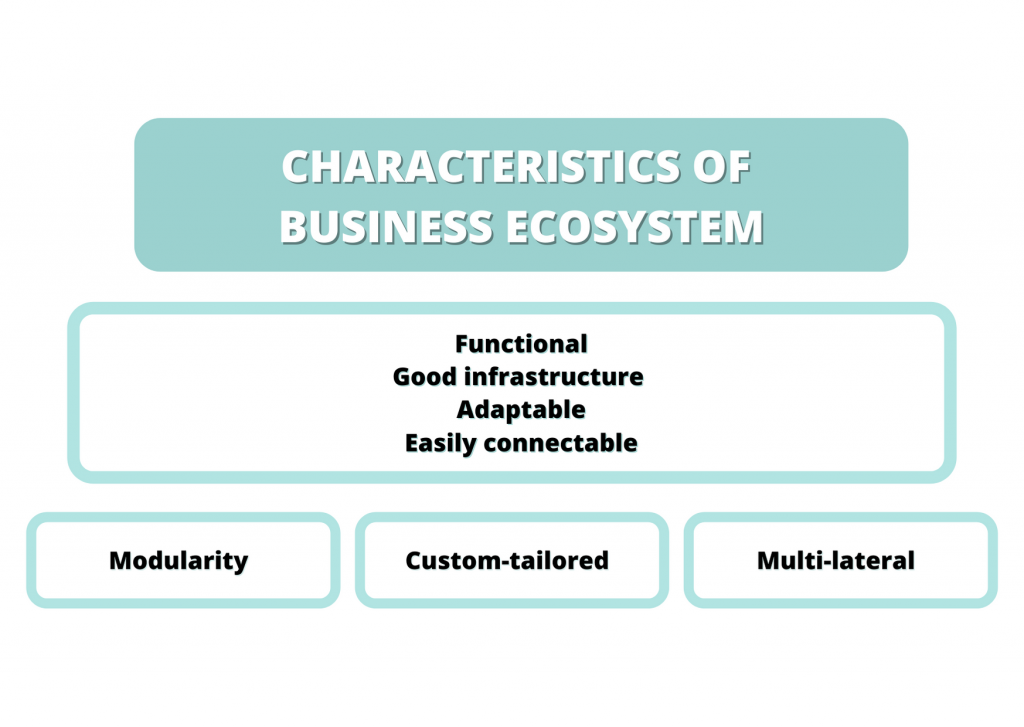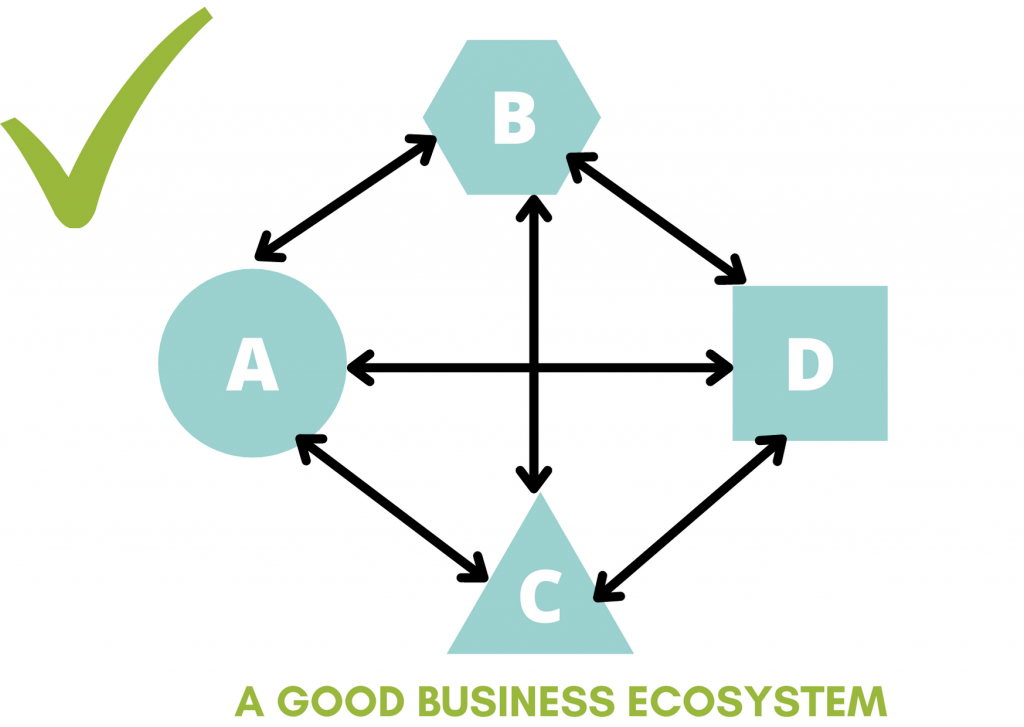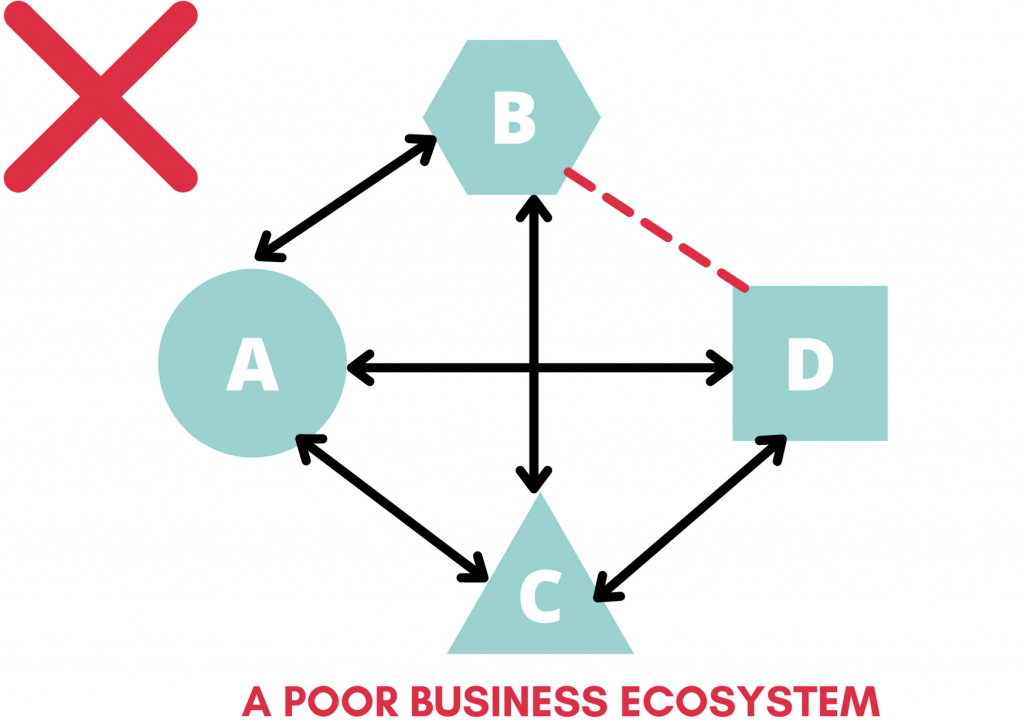Introduction: What is a Business Ecosystem?
Recently, the term “Ecosystem” has been a buzz word amongst business owners and in business forums, but what exactly does it mean? It has a similar meaning to the scientific definition of Ecosystem, but for businesses, the Ecosystem describes a network of organizations that cooperate together to deliver a specific product or service. A business Ecosystem can also be seen as a networked yet relatively free collaboration between several companies from one or more industries. Thereafter, the value chain of a company will expand into a value network with several partners.
Organisations within an Ecosystem are largely independent economic players that come together to create products/services. Some examples of organisations include suppliers, competitors, customers, government agencies and more. It is important to note that no two businesses will have the same Ecosystem, as each Ecosystem should be characterized by each business’ specific value proposition. In addition, it should be clearly defined to solve a problem, and also work with a group of organisations that specifically suit the business’ needs.
As knowledge management becomes increasingly essential to competitive success, the capabilities to build and manage an extensive Ecosystem with the right set of relationships between partners also remains critical.
Types of Business Ecosystems
There are mainly 2 types of Business Ecosystems: Solution Ecosystems and Transaction Ecosystems.
Solution Ecosystems create and/or deliver a product or service by coordinating various contributors. For such systems, there is often a core firm that helps to oversee the construction of these contributors. During the development of a new solution, suppliers of the core firm can be part of the Ecosystem because they are independent. Most importantly, it is to ensure that their innovation activities are coordinated with the other players. Once the basic innovation is accomplished, such suppliers may be restricted to a minor role in a hierarchical supply chain.
Transaction Ecosystems match or link participants in a two-sided market through a (digital) platform. In fact, there are many such platform businesses today. Think of Carousell, which links independent sellers and buyers; Grab which links drivers and riders; and Jobstreet that links individuals with companies.
Characteristics of a Business Ecosystem
Like any system, a business Ecosystem needs to be functional, has a good infrastructure, is adaptable and is easily connectable. However, a business Ecosystem also has other special characteristics that make it so unique and useful for businesses to utilise.

Firstly, a good business Ecosystem should have modularity, which is the ability to separate and recombine the system’s various components. While this term is mostly used in programming, it is applicable in a business Ecosystem context as the network of organisations consists of organisations that are designed independently yet function together as a whole. This feature will allow the organisations within the network to be able to work on their own and not be entirely dependent on the existence of the Ecosystem to continue operations.
Next, Ecosystem participants also need to ensure their contributions to the Ecosystem are custom tailored to suit the value proposition of the Ecosystem they are in. Another factor is that the Ecosystem-specific contributions must also be mutually compatible so that the network of organisations can cooperate with one another.
The organisations within the network must also be multilateral, meaning that the organisations should not work exclusively with one other organisation within the network. The failure of one relationship will lead to the downfall of the entire Ecosystem, despite there being successful relationships between certain organisations.


For example as shown in the diagrams above, there are organisations A,B,C,and D in the Ecosystem. Even if A successfully works well with B,C and D, if there is a contract failure between B and D, the entire business Ecosystem will not be able to function.
What ForBis’ Ecosystem Looks Like
At ForBis Accounting, we pride ourselves in having a business Ecosystem structure. Our solution Ecosystem aims to provide professional services to our clients through our core firm: ForBis Accounting. ForBis Accounting provides Advisory, Bridging and Compliance services to companies.
In addition, we have two subsidiaries, namely ForBis Human Capital and ForBis Ventures. These two subsidiaries work hand in hand to streamline the processes to provide the most personalised services for our clients. ForBis Human Capital provides manpower services like payroll, visa applications, strategic branding, recruitment and selective job redesign, remuneration and compensation drafting and contract drafting etc. While ForBis Ventures buys small stakes in companies with high potential. In otherwards, ForBis Human Capital and ForBis Ventures are the complementors of ForBis Accounting.
A large part of Bridging means to repeatedly recommend services of our clients to other clients (provided they are good and reasonably priced). We have partnering firms such as other Accounting firms, Law firms, Professional engineers and Consultancy firms that deal with grants. We work with them and our associates to provide complete services to our clients.
For example, we work with law firms when start-ups want to do licensing of their contracts or when they want to seek legal advice. We also assist with the application of intellectual property and any other professional help needed.
Our relationship with our customers are in the form of business-to-business (B2B). Majority of our customers are in the Fintech, Retail, and Legal industries, Social Enterprises and Institutions of Public Character.
Benefits of having a Business Ecosystem
Establishing a business Ecosystem is one of the key drivers to success. Being able to work with many partners provides abundant opportunities for companies to attain achievement that is beyond the capabilities of its own. They will be able to collaborate with companies specializing in other sectors or industries, giving both companies economic advantages. It may also offer access to additional creativity in the creation of solutions.
Companies are able to gain insights from suitable partners on how to adapt suitable structures, develop and implement effective business models, and gradually transform their value chain. Furthermore, as the industry gets more competitive, many companies are seeking to focus on fewer core activities to focus on their positioning. Through partnerships, it allows them to reallocate their resources to deepen their core competencies.
Overall, it can be seen as a long-term strategic decision for the company’s development and focus. Companies are able to quickly launch innovation culture upwards and have huge potential for SMEs.
Cons of having a Business Ecosystem
While there are many advantages of having a business Ecosystem, there are also a few disadvantages. One of them is the possibility of high transaction costs that results from having a multitude of relationships. Some of these relationships are less defined and regulated. If they are not monitored or controlled, they can unintentionally outweigh the extra customer value that the Ecosystem generates.
In addition, since it consists of largely independent economic players that agree to collaborate, it implies that each participant only has limited control of the overall system. The lack of control may worry some companies. The moment companies are made known to be associated with each other, any damage done by one company may greatly affect the other in terms of brand reputation.
Conclusion
Before establishing a business Ecosystem, it is important to decide whether the business is really in need of one. Since the word ‘Ecosystem’ has been such a hot topic these days, many managers of firms have the fear of missing out on something essential and feel it is necessary for their businesses to have an Ecosystem, without carrying out their analysis.
Despite all the benefits that an Ecosystem can bring to a business, as discussed above, there are also cons to having or being part of a business Ecosystem. This is especially so for organisations that are not clearly aware of their value proposition and goals.
Business Ecosystems are not the only model businesses can use for governance. There are other systems such as a hierarchical supply chain or a vertically integrated model, both of which do not lose out in terms of effectiveness to the business Ecosystem model. Businesses must realise their needs in order to choose the most suitable model that will work well for them, and not blindly follow industry trends as it may lead to unexpected repercussions.
Authors:
Celesdia SOH Jia Hui
Business Development Associate
Chrislyn WONG Shu En
Business Development Associate
Nur FADHILAH Bte Abd Fazil
Business Development Associate
Michelle CHEN
Business Development Associate
Editor:
Ryan Adnin GOH
MBa, Certified Employment Intermediary (KAH)
Director of Advisory
References
Bossen, K. (2020). Business ecosystems: how they benefit SMEs. DMEXCO.
https://dmexco.com/stories/business-ecosystems-how-they-benefit-smes
Pidun, U., Reeves, M., & Schüssler, M. (2019). Do You Need a Business Ecosystem?. BCG.
https://www.bcg.com/publications/2019/do-you-need-business-ecosystem
Williamson, P. & De Meyer, A. (2010). Ecosystem advantage: How to boost your success by harnessing the power of partners. CJBS.
https://www.jbs.cam.ac.uk/wp-content/uploads/2020/08/wp1006.pdf

